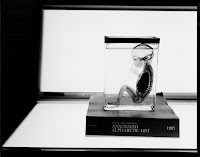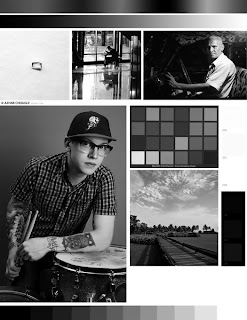Better in Black and White: Digital Silver Imaging
Collections
Artist’s Gallery Talk @ The Griffin Gallery at Digital Silver Imaging
Je Ne Sais Quoi
Articulate and humor-filled descriptions of his creative process informed and entertained an eclectic audience at the Griffin Museum of Photography at Digital Silver Imaging‘s gallery talk last evening. Photographer and videographer, Jonathan Stark, waxed poetically on the feelings evoked by France, shooting with film and the “magical faith-based” moments of creating art.
Armed with 3 Nikon cameras, loaded with color and black and white film, Stark approaches his work with an open respect for the dialog between the subject – animate or not – and the shooter. Eagerly seeking resonance with his subject his goal is to “capture the energy.” The most important lens being that of his own emotion, imagination, and aesthetic. His desire to make a photograph overrides any sense of timidity or inclusion in another’s intimacy. Ask him about shooting the Hassidim in Jerusalem preparing for Passover.
A curious documentarian, Stark, exposes himself to the culture and ritual he discovers while traveling. What separates a photograph from a snapshot? In his view it is the willing involvement of the shooter to engage and exercise a disciplined and attentive awareness to one’s inner vision. An artist transforms the obvious, moving beyond mere representation. Stark notes black and white photographic images convey emotion and render moments timeless in a way color cannot.
A diehard film fan, he favors the nuance of a silver gelatin print which cannot be mimicked by “spraying” ink on paper. Giclee and silver gelatin are different animals. Just as a diamond traveling across vinyl picks up the peaks and valleys of sound in a manner not replicated by high definition electronic transfer – we sense the difference in output despite the ability of our eyes to register the minute pixilation used in ink jet printing.
Darkroom magic is that inexplicable happening when the image unfolds its secrets – the culmination of subject, light, exposure, framing, and myriad processes, both human and chemical, that birth a photograph. In Stark’s opinion art reflects relationship.
Stark approached Digital Silver Imaging’s output as an experiment. He was both pleased and surprised with the results. “Digital Silver Imaging’s printing technology enabled me to take a color transparency and convert it to black and white, which revealed the character that appealed to me, but had not translated in color. The DSI silver gelatin print made the image sing.”
You can view all the images from the exhibit here. Contact Eric Luden at Digital Silver Imaging for information about purchasing any of the prints from this exhibition.
Digital Silver Imaging Impresses the Press
Shutterbug’s Steve Bedell interviewed Eric Luden about the current state of black and white printing and the tools that are available to photographers to obtain quality prints. The interview will run in the February 2011 issue of Shutterbug.
Read a pdf of the interview on your computer or grab a copy of Shutterbug.
Stay in touch with us on Facebook for gallery news and information about our lab.
A Warm Reception
Friday’s opening of Jonathan Stark’s France:Chaleur was a celebration of the warmth found in sweeping views of Paris, the French countryside and the depth of character of it’s people. Shot on film during successive trips abroad the fiber silver gelatin prints are as soulful as their subjects. Intimate glimpses of Gallic pride shine from the soft eyes of a daper, elderly gentleman and the crisp attentiveness of a grandly mustached geradement. Stark caught Paris from the seat of a famed carousel, which no longer exists, allowing the vantage point of a bird surveying the quiet elegance of Hausmann’s orderly and grand design for the city of light. Caught at night the Eiffel tower is it’s quintessential playful self. Stark unobtrusively documents the serious pastime of a game of boule and the care and precision given to measuring the competition. These Black & White images exude a reverence of the ordinary while acknowledging the depth of tradition. Powdered truffles, fluted madeleines and red wine aside, these images transport the viewer to a place where time honored craft and care warm the heart.
Friday, November 19, 2010 opening reception 6 -8
Talk at Digital Silver January 11, 7 PM
Tom Ashe from The School of Visual Arts and color management
For the past six years in the Fall and Spring semesters I have been teaching a course I created in Digital Printmaking and Color Management as part of the BFA Photography program at the School of Visual Arts in New York City. The aim of the course is to help the students to be knowledgeable about different printmaking technologies and how to produce the best quality digital prints possible. One of the biggest challenges for my students is creating good quality digital black-and-white prints. That’s why an important part of the Black-and-White Digital Printing Assignment is to have the students make a true silver gelatin digital print. Although, most students come to the class not knowing that this is even an output option, they are even more surprised to find out they can get digital output on the same fiber based silver gelatin photographic materials they have loved in the traditional darkroom. Digital Silver Imaging is one of the few service bureaus in the country and the world that produce fiber based silver gelatin digital prints. Luckily for us, Eric Luden and his staff have been kind enough to help our students to experience their digital black-and-white images on these silver gelatin materials with their unique aesthetic and technical qualities.
Tom Ashe is the associate chair of MPS Digital Photography Department, School of Visual Arts in New York. He is also an excellent photographer & consultant to the photographic industry. Visit his website for more information.
One of Tom’s students, Azhar Chougle, had this to say about working with us:
“It has been an absolute pleasure to be able to work with Eric on producing digital silver gelatin prints. Working with labs is always a twisted and convoluted ballet, but in this case the process was surprisingly simple and straightforward. Given Eric’s vast experience in the field, he demonstrates a firm understanding of his process and requirements. At the same time, he is incredibly personal and accommodating. The most important factor is of course the prompt delivery and the print itself. The images produced take on a refreshingly analog quality, a welcome deviance from the manufactured predictability of the inkjet process. The papers (especially the fiber) are thick, heavy and feel exquisitely organic, something that would be expected walking out of a darkroom rather than a digital lab. I would say it is impossible to replicate the aura and feel of a silver gelatin print, which makes this avenue of digital output a very worthwhile exploration.”







